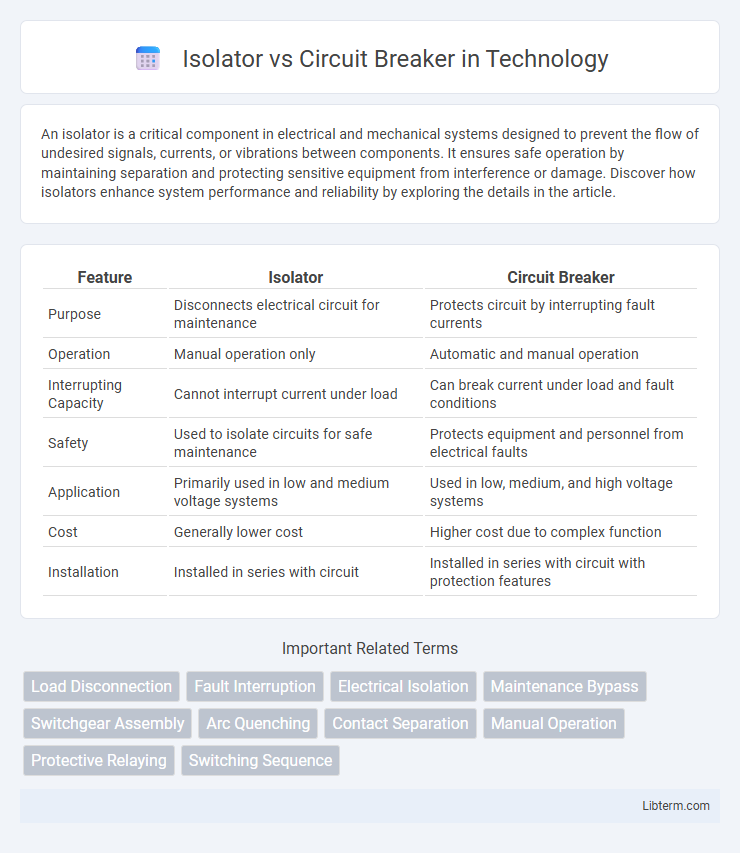An isolator is a critical component in electrical and mechanical systems designed to prevent the flow of undesired signals, currents, or vibrations between components. It ensures safe operation by maintaining separation and protecting sensitive equipment from interference or damage. Discover how isolators enhance system performance and reliability by exploring the details in the article.
Table of Comparison
| Feature | Isolator | Circuit Breaker |
|---|---|---|
| Purpose | Disconnects electrical circuit for maintenance | Protects circuit by interrupting fault currents |
| Operation | Manual operation only | Automatic and manual operation |
| Interrupting Capacity | Cannot interrupt current under load | Can break current under load and fault conditions |
| Safety | Used to isolate circuits for safe maintenance | Protects equipment and personnel from electrical faults |
| Application | Primarily used in low and medium voltage systems | Used in low, medium, and high voltage systems |
| Cost | Generally lower cost | Higher cost due to complex function |
| Installation | Installed in series with circuit | Installed in series with circuit with protection features |
Introduction to Isolators and Circuit Breakers
Isolators and circuit breakers are essential components in electrical systems designed to enhance safety and reliability. An isolator is a mechanical switch that disconnects a circuit from the power source to ensure safe maintenance, typically operated when the circuit is de-energized. Circuit breakers are automatic protective devices that interrupt fault currents by detecting overload or short circuits, thus preventing damage to electrical equipment and maintaining system stability.
Definition of Isolator
An isolator is a mechanical switch designed to disconnect a part of an electrical circuit, ensuring complete de-energization for safe maintenance and repair. It operates only when the circuit is not under load, unlike circuit breakers which can interrupt current flow during faults. Isolators provide clear visible isolation, preventing accidental energization and enhancing workplace safety.
Definition of Circuit Breaker
A circuit breaker is an automatic electrical switch designed to protect an electrical circuit from damage caused by overload or short circuit by interrupting current flow. It resets automatically or manually after tripping, enabling the restoration of electrical service without replacing components. Unlike an isolator, which is used primarily for ensuring a circuit is completely de-energized for maintenance, the circuit breaker provides both control and protection functions in electrical systems.
Basic Working Principle
An isolator operates by physically disconnecting a section of an electrical circuit to ensure safety during maintenance without interrupting the main power supply. Circuit breakers automatically detect fault conditions such as overcurrent or short circuits and swiftly interrupt the electrical flow to protect the system from damage. While isolators provide a visible break ensuring no current flow, circuit breakers offer automated protection by breaking the circuit under abnormal electrical conditions.
Key Differences Between Isolator and Circuit Breaker
Isolators are mechanical switches used to disconnect a circuit from the power source for maintenance, ensuring a safe working environment, whereas circuit breakers automatically interrupt current flow during faults to protect electrical circuits from damage. Isolators operate only when the circuit is de-energized and cannot interrupt current, while circuit breakers can function under load conditions and provide fault protection by breaking the circuit during overloads or short circuits. The key difference lies in their purpose: isolators ensure isolation for safety, and circuit breakers ensure protection by interrupting faulty currents.
Applications and Usage Scenarios
Isolators are primarily used in electrical substations and high-voltage systems to ensure complete disconnection for maintenance, providing a visible break in the circuit to guarantee safety. Circuit breakers serve in residential, commercial, and industrial settings to automatically interrupt power flow during overloads or short circuits, protecting equipment and preventing fire hazards. While isolators require manual operation and are used when the circuit is de-energized, circuit breakers operate automatically under fault conditions to maintain system stability.
Safety Features and Risk Considerations
Isolators provide a visible break in the electrical circuit ensuring the system is completely de-energized for safe maintenance, while circuit breakers automatically interrupt current flow during overloads or short circuits to prevent damage and fire hazards. Isolators lack automatic tripping capability, relying solely on manual operation, which introduces risk if not properly engaged before maintenance work. Circuit breakers enhance safety by incorporating fault detection and rapid disconnection, minimizing electrical accident risks and protecting both equipment and personnel.
Advantages of Using Isolators
Isolators provide a clear visual confirmation of disconnection, enhancing safety during electrical maintenance by ensuring no current flows to the circuit. They have a simple design with fewer moving parts, resulting in lower maintenance costs and increased reliability in isolating electrical equipment. Isolators also enable the safe isolation of equipment without tripping the entire electrical system, allowing for targeted maintenance and minimizing downtime.
Advantages of Using Circuit Breakers
Circuit breakers offer superior protection by automatically detecting and interrupting fault currents, minimizing the risk of electrical fires and equipment damage. They can be reset after tripping, which reduces downtime and maintenance costs compared to isolators that require manual operation and do not provide fault protection. Circuit breakers also enhance safety by quickly responding to overloads, short circuits, and ground faults, ensuring more reliable and efficient power distribution in residential, commercial, and industrial electrical systems.
How to Choose: Isolator vs Circuit Breaker
Choosing between an isolator and a circuit breaker depends on the specific electrical system requirements and safety protocols. An isolator is primarily used to ensure a circuit is completely de-energized for maintenance, providing a visible break but lacks automatic trip functionality, making it suitable for systems where manual isolation is sufficient. A circuit breaker offers automatic protection by interrupting fault currents and quickly restoring power, ideal for environments requiring real-time fault detection and system protection.
Isolator Infographic

 libterm.com
libterm.com